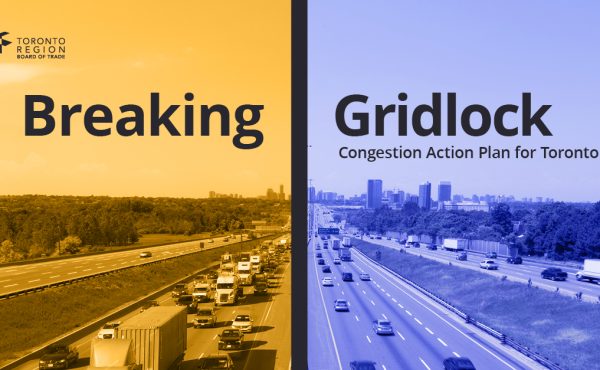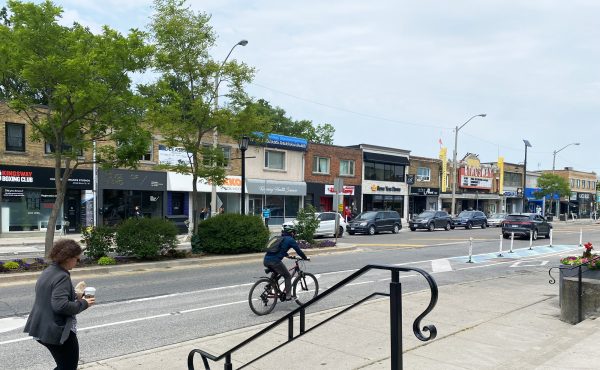
Sometimes it takes a visual illustration to make the strongest argument.
The above image is 42 Brompton folding bikes placed in one parking spot. The image below is the amount of space needed for the same amount of people to take a car, bus, or bike.

top photo by Jam Design




23 comments
I’ve seen a similar photo from the U.S. and this makes clear the huge difference we can make with public transportation and cycling. Love it!
I use the bottom graphic whenever I give a lecture. Now I have a companion photo.
Effective!
The Brompton photo is cute, but it’s not a practical example of how many bikes can fit into a car parking space. Nobody would actually park their bikes like that. Now…maybe if they built two rows of 7FBx3FB storage shelving within the same car parking space, that would be practical! (“FB” is the standard “Folded Brompton” unit of measurement)
A much, MUCH better example is this one from Portland, via Streetsblog:
http://www.streetsblog.org/2008/08/15/corrals-and-oases-bike-parking-in-portland/
One flaw with the Muenster example is that they should have framed the photos exactly the same. The car photo is zoomed in much closer, so you don’t get the same perspective.
I would dispute that Vic: here at the building where Spacing has an office, we have 75% people (about 150) commuting on bike and not enough bike parking outside or inside. We have approached the city and the councillor to take over two car parking spots in front of our building for bike parking. This image can help us convince the Parking Authority to allow for bike racks. You’re correct that no one would park like this, but it demonstrates the lack of space bikes need to park compared to a car.
I should say that all parties have agreed to do this bike parking project including the PA.
I agree with Vic — it’s a nice picture for a lecture, but if you have to go up against cold-hearted city engineers you are better off showing them actual examples and then hit them with the why-can’t-Toronto-be-as-good-as-(insert city) argument.
Here are some shots to further the cause:
Munich – http://bit.ly/IslBO
Netherlands – http://bit.ly/lIM7V
Montreal – http://bit.ly/ps78S
Seattle – http://bit.ly/8h8R8
London – http://bit.ly/XmH6W
Chicago – http://bit.ly/vW8un (Oak Park)
just love it!
I think a car parking spot will probably accommodate 8-10 bikes. More importantly, space required for a moving car can accommodate many more moving bikes.
I love biking but a statistic I’ve never seen is how many bikes per hour can a bike lane carry? A car lane can carry up to 2200 cars an hour, not to mention buses, trucks and emergency vehicles. I know it’s not very sexy to say this but my ideal city includes both bikes and cars. Not a zero sum game.
Tom B: the fair comparison is not how many cars/hour a car lane can carry vs. how many bikes/hour a bike lane can carry.
Rather, take a took at how many people/hour one car lane can take when those people are on bikes vs. in cars (at the usual 1.2 or whatever average occupancy).
This is very effective! Sure it isn’t perfect but you know when even an 80 year cyclist wants to park his bike and can’t find a spot, we need more bike space. Add the destructive effects of the car, and it all adds up to a wonderful message.
Tom,
I don’t have a stats, but I think I can do a guessitmate: say a traveling bike takes 3 meters of space, and a timid travel speed of 15km/h, I’d say a bike lane is capable of carrying 5000 bikes per hour, i.e., more than twice as many as the car lane, and takes about 60% less space than a car lane (assume a 3.5m wide car lane vs. a 1.5m wide bike lane)
Thanks for these other links, especially the Portland video from Vic. We only need one “car” parking spot per block on a main street to accommodate 8-10 bicycles. Perhaps about 2 spots per block for longer blocks.
Lane capacity is based on following distance (or gap) between your vehicle (including bikes) and the vehicle in front of you. General rule of thumb in driving is to keep a two second gap. There are 3600 seconds in an hour, so if everyone is keeping a 2 second gap, basic lane capacity is 1800 vehicles per hour.
This value is called Saturation Flow Rate and is the basis for capacity calculations in traffic engineering. In urban conditions, people often leave smaller gaps so this saturation flow rate can go up to 2000 or even 2200 busy commuting traffic.
Lets assume a basic hourly of 1800. Signals then basically chop that number in half as they alternate from street to street. Assuming even green ratios between streets, base lane capacity would be 900 cars per hour. Take out lost time from amber and all red and you’re down to about 800 vehicles per hour per lane.
The City of Toronto’s regional model (EMME/2) assumes an hourly capacity of 800 for arterial streets. For busy downtown streets such as King/Queen with streetcars and lots of parking/taxi activity, the model assumes an hourly capacity of 500 vehicles. This is the range of volumes you’d see per lane if you sat and counted for an hour.
Bikes operate under similar parameters so capacities would be similar for bike lanes. But it all depends of how close cyclists follow each other. The perception/reaction and stopping time on a bike is probably shorter than that of a car, but 5000 bikes per hour would mean a following gap of 0.72 seconds which seems a bit close for a reasonable level of comfort.
MP.
(Transportation Planner)
Hi, Marc,
while your argument certainly makes sense, but if you look at College St. at rush hour, you will see a lot of bikes with a following gap at or under that 0.72 seconds (and of course a lot of cars under 2 seconds too). I’d argue that is actually reasonably safe. Why? First of all, unlike cars, which pretty much have to come to a full stop behind the car in front to avoid an accident, bikes are much more agile, if the bike in front of you come to a sudden stop, a slight change of direction can get you out of harm’s way, even if you cannot stop in time; more importantly, unlike a drive following another car closely, cyclist gets a much better view of what is in front even if he/she is following another bike closely, so he/she will have as much time as the one in front to react. Of course, as you have mentioned, the 5000 number has to be cut down a lot to account for traffic light and that sort of thing, just like the case for cars. In the end, I think the result is the same, a bike lane can probably carry up to twice as many people as a car lane does, using about 40% of the space.
Agreed that bike lanes certainly have the potential to be more efficient because bikes are more nimble. Although while it may be safe on a bike to follow at a very short gap, it may not actually happen in practice because of rider comfort level. I don’t know however because I’ve never studied it although you say it happens.
The best way to estimate theoretical capacity would be to do a saturation flow study on a very busy bike lane (College for example). To do the study, you count the number of bikes that pass a point in 5 second intervals.
All you need to do is measure the amount of time between say the 4th bike (after the light goes green) and the 7th, 8th or 9th bike. Take that time and divide by the number of bikes and you have the length of gap in seconds. Divide 3600 by the gap and you have your capacity per hour of green. Adjust for signals and other factors as appropriate, and you have theoretical capacity.
Now that I’m thinking of this if you see a guy on the street corner somewhere on College with a stopwatch it might be me! haha.
Another thing about the capacity of bike lane: bike lane is much more resilient than car lane in real world traffic condition. If you have a single car lane, you cannot pass a slow moving car; if a car stalls or stops temporarily, the whole lane is blocked; even with two lanes, a stall car will take out one lane and take a huge bite on the actual capacity of the road. But with one bike lane, you can still pass a slow moving bike. A stall bike? Is that even a problem?
Good idea Marc, I want to try that myself 🙂
Side topic, but I like how in Europe their cars are far smaller than they are here. Smaller cars may not be as sexy, but are far better to maneuver and are far more fuel efficient.
Good points and I’ll admit I was being a bit disingenuous – 2200 cars per hour would be an expressway lane so its not a fair comparison. My real point (in mentioning buses and trucks for instance) is that “car” lanes and bike lanes don’t serve the same purpose in most cases. City roads should have both, ideally. The greatest potential of cycling is to replace SOME of the cars on the road, resulting in a more optimal urban transport system.
I am thinking that if they had taken a picture of 2 Smart cars in one of the parking spots, that it will still show how much real estate we have given over to motor vehicles. They could have even made a wider shot and just dropped an office cubical into another space just to show how much space is wasted.
42, eh? Now we know the question to the ultimate answer.
The top picture is for parked cars and bicycles but the second one from Muenster also is. Vehicles in motion use much more space and use it very differently, see http://john-s-allen.com/blog/?p=7 .